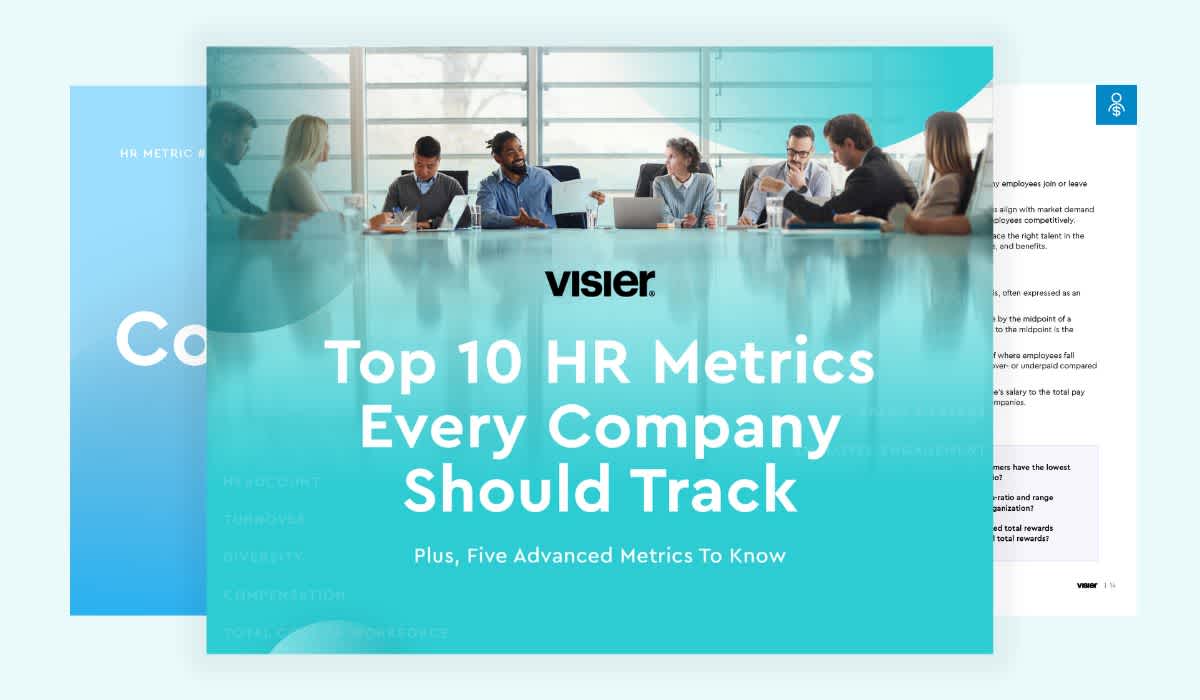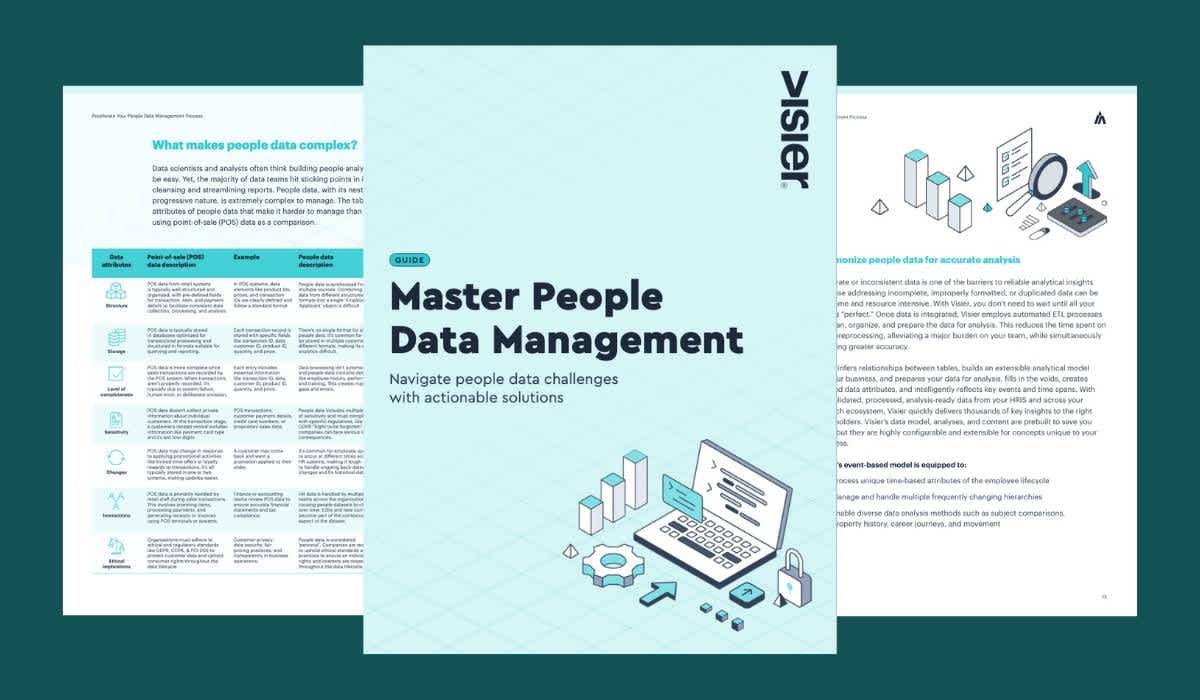Talent Analytics: What Is It and How Can I Use It?
Talent analytics uses a data-centric approach to decision-making regarding your workforce. Learn more.

Talent analytics is a data-centric approach to decision-making regarding current and future employees. It involves the use of software tools to gather information about a company’s current and future workforce. The big goal is to make better business decisions.
Talent analytics also helps the human resources team understand what makes a good employee, and what motivates them. As a result, they’ll be able to make better hiring decisions, increase engagement, and reduce turnover.
How much does talent analytics truly help? A lot. A study by Bain & Company found that organizations that use talent analytics are 40% more productive than those that don’t.
So let’s take a closer look at talent analytics, what data you need, how it can help, and some practical examples.
What types of talent data should you collect?
Talent analytics revolves around data, so collecting the right ones is crucial. Here are the most important data categories to focus on.
Sourcing data
This includes data from:
Social media. Here you should focus on finding out which channels are the most effective at recruitment, the cost per hire, and the number of candidates each channel can generate.
Job boards. Tracking this data can show you how well your job adverts are performing. Look at things like the number of candidates you’re getting, the number of hires, or the demographics.
Applicant tracking systems. These systems will help you see where applicants come from, what role they applied for, and more.
Candidate relationship management. Finally, you’ll want to analyze the number of candidates that abandon the application process, and where they were in that process when they dropped out. Time and cost to hire, referral rate, and quality of hire are also included here.
Employee data
Metrics to look for include:
Employee attrition rates, or the rate at which employees leave your organization;
Employee engagement, which can include survey results, any other qualitative or quantitative way to measure employee engagement;
Employee satisfaction, which can also include qualitative and quantitative pulse checks, employee surveys, and exit and stay interviews;
Benefits, including benefits uptake, usage, and general satisfaction
Don’t forget to look at both new and old employees. You’re trying first to analyze how new hires perform. But you also want to see how your long-term employees are doing, and what’s keeping them motivated and engaged.
Recruitment data
Last, but not least, you need to collect data about recruitment. This will help you see how effective your talent acquisition strategy is and where you can improve.
Bad hires can be very costly. They make the HR department waste time and resources. But they can also slow down the production process.
Manually screening candidates is difficult. Taking a data-driven approach can be a lifesaver. It can help you see what candidates are likely to perform well and can offer insights into the type of personality, experience, and skills that are best for a certain role.

How do you use talent analytics?
Talent analytics can help you make better business decisions. To use it, you’ll need to take a few steps first. This includes:
Establish your goals. You need to know what you’re working towards in order to achieve it. Define clear, measurable goals before you gather and analyze data.
Choose the metrics you��’ll follow. To measure results, you need to look at the right HR metrics. What do you need to monitor? Is it employee engagement? Turnover?Headcount? Monitoring the correct metrics will help you avoid mistakes and get the best results.
Choose the right software. This will come with an investment. You’ll not only need to purchase the software but also take time to configure and deploy it. Don’t worry though. Talent analytics, when implemented correctly, has a high ROI.
Once you have your goals, metrics, software, and data, you can start the analysis process. A good visualization tool will come in handy. Depending on your goals and your metrics, there are different ways you can visualize and analyze your data, including:
A comparison;
A relationship;
Distribution of variables.
Each type of analysis will help you uncover hidden insights from your talent analytics data that you can use to make informed decisions about your HR and recruitment programs.
5 talent analytics insights you can use
Talent analytics can offer a number of useful insights to help improve your HR and recruitment programs. These include:
Hiring insights
Predicting employee attrition
Understanding your workforce
Strategic workforce planning
Optimized internal processes
Let’s dig into each.
1. Hiring insights
With talent analytics, you can get clear insights about your candidates. The software can process the applications unbiasedly. For instance, it can look for certain qualifications, or other keywords and select the best candidates for the interview phase.
You can also use it to understand various hiring metrics. Things to look at include:
Cost per hire;
Time to hire;
Source of hire;
Offer acceptance rate.
2. Predict employee attrition
By tracking data related to your employees, you can forecast and predict employee attrition. Collect data related to:
Employee behavior over a few months;
Last promotion data;
Employee tenure, especially since the last promotion;
Financial data such as salary, incentives, and any other benefits;
Performance;
Absenteeism.
You can also look at more personal information that includes marriage, a recent death in the family, or children.
On its own, none of this information can predict attrition. But analyzed together, over an extended period, you may see some patterns emerge.
3. Understand your workforce
Here, we’re talking about the big picture. You’re still gathering data about each employee, but your goal is to view the performance of your workforce as a whole. Aspects to analyze include:
Team dynamics;
Demographics;
Diversity;
Inclusion;
Compensation discrepancies;
Churn rate.
4. Strategic workforce planning
With talent analytics, you can look at your employees and see if they provide the necessary skill sets for your company. You can assess your team’s performance and identify any skill gaps versus your future workforce needs. You can also take things further to see:
Who are the best performers;
Who has the potential to take on a leadership role;
Who would be better in a different role;
Who isn’t a good fit.
All this allows you to make better decisions about promotions, incentives, and even hiring for new roles.
5. Optimized internal processes
By analyzing both hiring and internal workforce metrics, you can optimize your internal processes. This includes everything from:
Onboarding;
Learning and development;
Promotions;
Inclusion;
And more.
4 examples of using talent analytics
As you can imagine, talent analytics—and the insights gained from it—can be deployed in many different ways in an organization. There are four examples of using talent analytics.
1. Automated application screening
Scanning through hundreds of applications takes a lot of time and resources, no matter how big your human resources department is. That’s why automated application screening is one of the most common uses of talent analytics.
With it, you use tools that can scan applicants’ submissions looking for certain keywords. These can be related to skills, studies, or even character traits and hobbies. In the end, you’ll get a much smaller applicant pool that you can move forward within the talent acquisition process.
Your HR department will still need to conduct several interviews and tests, but only the best people will be selected to go through this process.
2. Increased employee satisfaction
Employee satisfaction and engagement are key to business success. Without these things you can get high turnover rates, drops in productivity, and even bottlenecks in the supply chain.
Talent analytics can come to the rescue. A simple way is the use of surveys. These can be anonymous and they can help identify problem areas.
Are your employees feeling they’re treated fairly? Does everyone have equal opportunities or is there someone who feels stuck under a glass ceiling? Are they happy with their learning opportunities? What about relationships with one another and with the management?
All these things can give you insights into what’s happening with your employees and will help you increase satisfaction.

3. Better profitability
Better, faster hires, engagement, and satisfied employees all lead to increased profitability. But that’s not all.
A data-driven approach looks at everything: financial information, time management, training, and more. For example, you can look at the number of hours worked versus the production output.
You can use talent analytics to identify patterns that lead to decreased production and even fraud. These are not issues that happen from one day to the next. They develop over time. Data-driven analysis can spot these issues before they cause irreparable damage.
4. Brand awareness
Many think of branding as something related to publicity—to how your customers see you. They also tend to see it as something static. You create your brand once and it stays that way until you decide to change it. But things are more complex than that.
So how do you track brand awareness and how does talent analytics help?
Check how people are researching your company. Where does most inbound traffic come from?
Who are your applicants and how did they find out about the position?
Look at the platforms where you have the most success. Who’s interacting with you there and why?
Your brand needs to evolve. It can’t be static or you risk losing customers and even stop attracting top talent. Taking a data-centric approach can help you avoid all this, increase brand awareness, and reach your business goals.
Key takeaways
Talent analytics takes a data-driven approach to managing the workforce. Its benefits include:
Hiring top talent with ease;
Increased employee engagement and satisfaction;
Predicting employee attrition;
Better internal processes;
Increased profitability.
With talent analytics, you harness data you already have and use it in an efficient manner that will help you grow your business and achieve your goals.
Talent analytics FAQ
What is talent analytics?
Talent analytics is a data-centric approach to decision-making regarding current and future employees. It involves the use of software tools to gather information about a company’s current and future workforce. The big goal is to make better business decisions.
What are examples of talent analytics?
Examples of talent analytics and its benefits include automated application screening, auditing and improving employee satisfaction, driving better profitability, and building stronger brand awareness.
What is the role of talent analytics?
The role of talent analytics in an organization can include:
Offering hiring insights
Predicting employee attrition
Understanding your workforce
Enabling strategic workforce planning
Optimizing internal processes.


